- Courses
- GS Full Course 1 Year
- GS Full Course 2 Year
- GS Full Course 3 Year
- GS Full Course Till Selection
- Answer Alpha: Mains 2025 Mentorship
- MEP (Mains Enrichment Programme) Data, Facts
- Essay Target – 150+ Marks
- Online Program
- GS Recorded Course
- Polity
- Geography
- Economy
- Ancient, Medieval and Art & Culture AMAC
- Modern India, Post Independence & World History
- Environment
- Governance
- Science & Technology
- International Relations and Internal Security
- Disaster Management
- Ethics
- NCERT Current Affairs
- Indian Society and Social Issue
- NCERT- Science and Technology
- NCERT - Geography
- NCERT - Ancient History
- NCERT- World History
- NCERT Modern History
- CSAT
- 5 LAYERED ARJUNA Mentorship
- Public Administration Optional
- ABOUT US
- OUR TOPPERS
- TEST SERIES
- FREE STUDY MATERIAL
- VIDEOS
- CONTACT US
Cyber Security In India
Cyber Security In India
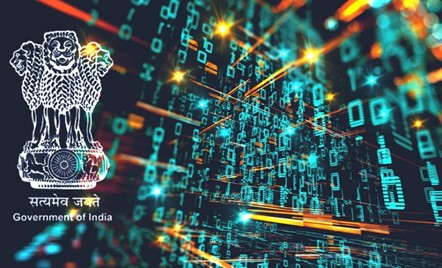
Cyber Security In India
What is cyber security?
1. "Cyber" refers to anything related to computers, networks, and digital technology. It encompasses everything from internet-connected devices and software to cloud computing and artificial intelligence.
2. "Cybersecurity" refers to the practice of protecting computer systems, networks, and sensitive information from unauthorized access, theft, damage, or other forms of malicious activity.
3. It involves the use of various technologies, processes, and best practices to prevent cyber-attacks and ensure the confidentiality, integrity, and availability of digital assets.
4. Cybersecurity is critical in today's interconnected world, where cyber threats such as hacking, malware, phishing, and ransomware attacks are increasingly common and sophisticated.
Importance of cyber security
1. Protecting personal information: Cybersecurity is important for protecting personal information from theft, fraud, and misuse. For example, if a hacker gains access to an individual's personal information, they may be able to steal their identity, open credit accounts in their name, or gain access to their financial accounts.
2. Securing financial transactions: Cybersecurity is essential for securing financial transactions and preventing fraud. For example, if an online retailer's website is not secure, hackers may be able to intercept and steal customers' credit card information.
3. Safeguarding intellectual property: Cybersecurity is crucial for safeguarding intellectual property, such as trade secrets, patents, and proprietary information. For example, if a competitor gains access to a company's trade secrets, they may be able to copy their products or services, resulting in lost revenue and market share.
4. Protecting critical infrastructure: Cybersecurity is important for protecting critical infrastructure, such as power grids, transportation systems, and water treatment facilities. For example, if a hacker gains access to a power grid, they may be able to cause a widespread blackout, resulting in significant economic damage and public safety concerns.
5. Ensuring national security: Cybersecurity is essential for ensuring national security and protecting against cyber attacks on government systems and critical infrastructure. For example, the WannaCry ransomware attack in 2017 targeted government systems and critical infrastructure in multiple countries, causing significant disruption and economic damage.
Types of cyber security threats
1. Malware: Malware is a type of software that is designed to harm computer systems, steal data, or cause other malicious actions. Examples of malware include viruses, worms, Trojans, ransomware, and spyware.
2. Phishing: Phishing is a type of social engineering attack in which an attacker sends a fraudulent email or message that appears to be from a reputable source to trick the recipient into providing sensitive information or downloading malicious software. Examples of phishing attacks include emails that pretend to be from a bank or online retailer, requesting login credentials or credit card information.
3. Password attacks: Password attacks involve an attacker attempting to guess or steal a user's password. These attacks can include brute-force attacks, dictionary attacks, and password spraying.
4. Denial-of-service (DoS) attacks: A DoS attack is an attempt to overwhelm a server or network with traffic or requests, rendering it unusable for legitimate users. This type of attack can be achieved by flooding the target with traffic from multiple sources, or by exploiting vulnerabilities in the system.
5. Man-in-the-middle (MitM) attacks: MitM attacks involve an attacker intercepting communication between two parties, allowing the attacker to eavesdrop on or modify the conversation. Examples of MitM attacks include session hijacking and Wi-Fi eavesdropping.
6. SQL injection attacks: A SQL injection attack is an attack in which an attacker injects malicious SQL code into a web form or URL to gain unauthorized access to a database. This type of attack can be used to steal sensitive information or manipulate the database.
7. Insider threats: Insider threats involve a trusted person within an organization who intentionally or unintentionally compromises the security of the organization. This can include employees who steal sensitive data, or employees who inadvertently cause security breaches through negligence or lack of training.
8. Cyber-physical attacks: Cyber-physical attacks involve an attacker compromising a physical system through a cyber-attack. Examples of cyber-physical attacks include the Stuxnet attack on Iranian nuclear facilities and attacks on power grids or transportation systems.
Cyber security challenges in India
1. Data: 14.02 Lakh cybersecurity incidents were reported in 2021 while 11.58 Lakh such instances were reported to CERT-In in 2020
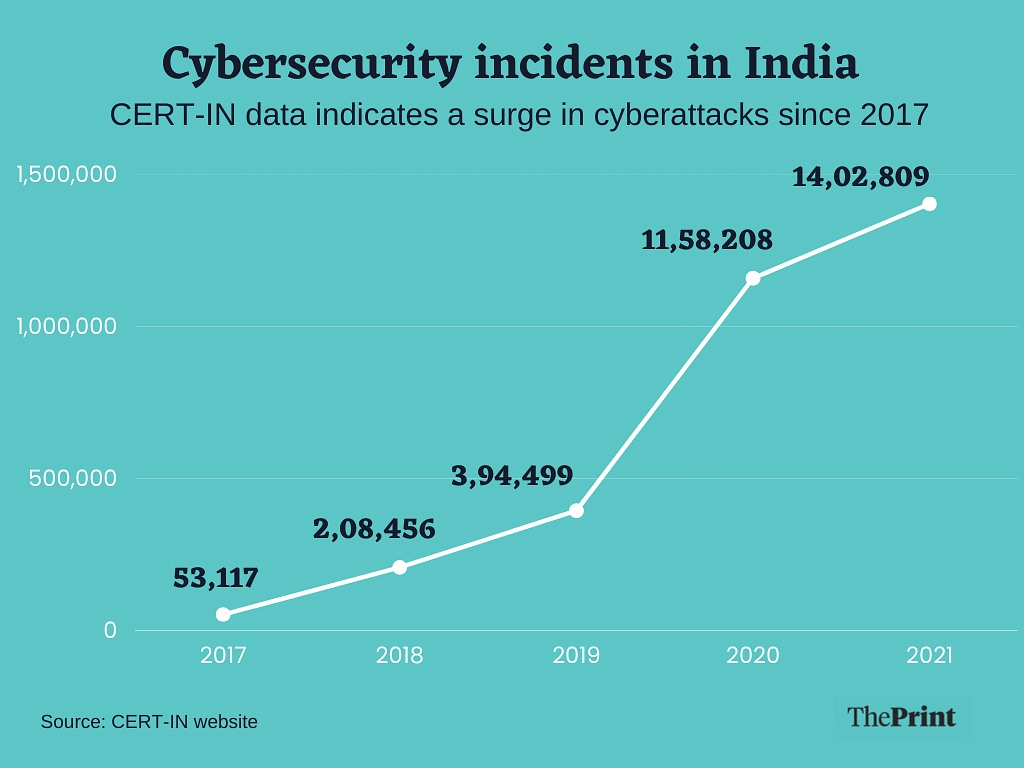
2. Imported IT cyber infrastructure: Most equipment and technology for setting up Cyber Security infrastructure in India are currently procured from global sources. These systems are vulnerable to cyber threats just like any other connected system.
3. Lack of Awareness: According to a survey by NortonLifeLock, 98% of Indian adults have engaged in risky online behavior, such as using weak passwords and not updating software, due to a lack of awareness about cybersecurity risks. This lack of awareness can lead to cyber attacks and data breaches.
4. Insufficient Infrastructure: According to a report by PwC, India has a shortage of over one million cybersecurity professionals. This shortage of skilled cybersecurity professionals can lead to vulnerabilities in the cybersecurity infrastructure of Indian organizations.
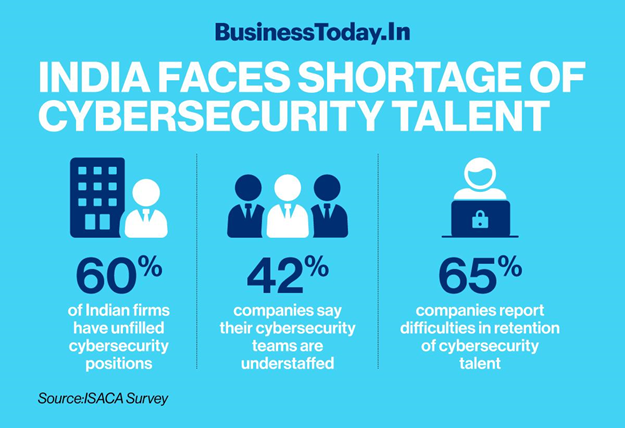
5. Cybercrime: According to the National Crime Records Bureau (NCRB), cybercrime in India increased by 63.5% from 2017 to 2018. Cybercriminals in India use a range of techniques, such as phishing, malware, and ransomware, to target individuals and organizations.
6. Cyber Espionage: According to a report by cybersecurity firm FireEye, India was the seventh most targeted country for cyber espionage attacks in 2020. Foreign actors targeted government agencies, defense establishments, and private companies for sensitive information.
7. Data Privacy: India has yet to pass comprehensive data privacy laws, leaving individuals and organizations vulnerable to data breaches and unauthorized access to personal and sensitive information. According to a report by the Internet and Mobile Association of India, India saw a 37% increase in data breaches in 2020.
8. Cyber Warfare: India is also vulnerable to cyber warfare, which could be used to disrupt critical infrastructure and cause significant damage. In 2019, India's power grid suffered a cyber attack that caused widespread outages, highlighting the vulnerabilities of critical infrastructure to cyber attacks.
Ensure your Civil Services Dream Career
Click Here to Book your free Counseling
Major cyber-attacks in India
1. JULY 2016
WANNACRY RANSOMWARE: The global ransomware attack took its toll in India with several thousands computers getting locked down by ransom-seeking hackers. The attack also impacted systems belonging to the Andhra Pradesh police and state utilities of West Bengal.
2. MAY 2017
DATA THEFT AT ZOMATO: The food tech company discovered that data, including names, email IDs and hashed passwords, of 17 million users was stolen by an ‘ethical’ hacker-who demanded the company must acknowledge its security vulnerabilities-and put up for sale on the Dark Web.
3. JUNE 2017
PETYA RANSOMWARE: The ransomware attack made its impact felt across the world, including India, where container handling functions at a terminal operated by the Danish firm AP Moller-Maersk at Mumbai’s Jawaharlal Nehru Port Trust got affected.
4. SEPTEMBER 2019
KUDANKULAM NUCLEAR PLANT: The NPCIL acknowledged in September 2019 that one of the systems at the Kudankulam nuclear power project in Tamil Nadu had been compromised by malware. At least 30 cyberattacks on India's electricity sector have been documented every day, including the discovery of malicious software in NPCIL's system. Dtrack malware attacked NPCIL. Hardcoded credentials for KNPP's internal network suggest a targeted attack. The Azeroth virus was linked to the Lazarus Group in North Korea.
5. APRIL 2021
DOMINO’S INDIA: Information related to customers over 180 million orders of Domino’s India were put up for sale on the dark web. CTO of cyber intelligence firm Hudson Rock, Alon Gal revealed it. He also said that someone asked for 10 bitcoin which costs Rs 4 crore for 13 terabytes of data that included credit cards records of 1 million people along with the details of 180 million pizza orders. The data included names, email IDs and contact numbers as well.
6. NOVEMBER 2022
AIIMS CYBER ATTACK: The country’s premiere medical institute was the subject of a major cyberattack in November last year which paralysed operations at the critical national infrastructure. Servers in the information technology network of AIIMS were compromised by unknown threat actors due to improper network segmentation, which caused operational disruption due to the non-functionality of critical applications.
Steps taken
1. Legal measure: The Information Act, 2000 was enacted as the primary law in India for dealing with cybercrime and digital commerce is the Information Act, 2000, which was amended in 2008.
2. Policy measures: National Cybersecurity policy, 2013: The policy gives the national cyberspace protection vision and strategic direction.
3. Institutional measures: Establishment of Cyber Emergency Response Team of India (CERT-In): Since 2004, CERT-In has been in operation. It is the national agency with the responsibility for responding to computer security incidents as they arise.
4. Cyber Crime Coordination Centre (I4C): The Union Government has decided to establish the Indian Cyber Crime Coordination Centre (I4C), which will serve as the highest coordination center for cybercrime prevention.
5. Cyber Swachhta kendra platforms: The Cyber Swachhta Kendra, which debuted at the beginning of 2017, provides a platform for users to analyze and remove various viruses, bots/malware, Trojans, and other malware from their systems.
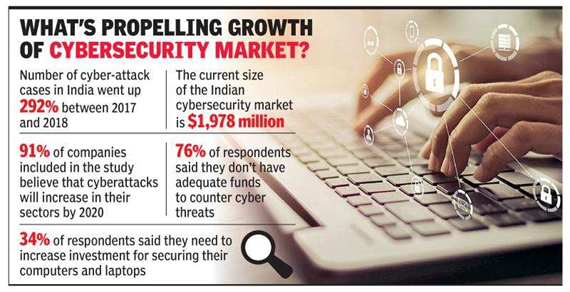
6. Cyber Surakshit Bharat initiative: The Cyber Surakshit Bharat initiative was launched by the Ministry of Electronics and Information Technology to educate Chief Information Security Officers (CISOs) and frontline IT staff from all government departments about cybercrime and build capacity for safety measures.
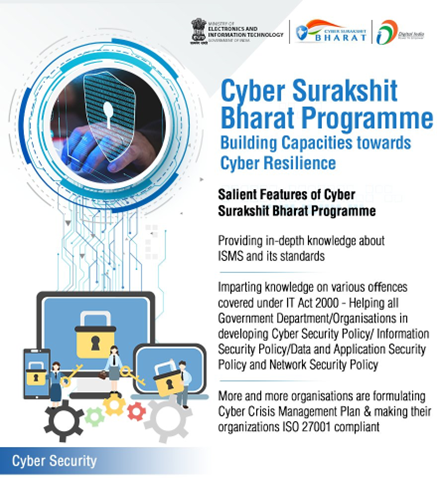
7. The Cyber Warrior Security Team: The government announced its intention to implement CWPF in 2018. It is proposed to be raised on lines of the Focal Furnished Police Power (CAPF).
8. The Cyber-Crime Prevention for Women and Children Program: The plan, which is put into action by the Ministry of Home Affairs, aims to reduce and prevent cybercrimes against children and women.
Way forward
1. Developing skills: Capabilities and capacity for application, equipment, and infrastructure testing must be built immediately.
2. Human resource development: Human resource development needs to be prioritized right away because doing so would result in an increase in the number of specialists who are capable of effectively managing the nation's cyber security.
3. More R&D in cybersecurity field: To address the growing threats to cyber security, more innovative technologies should be developed through R&D investments.
4. Improved Governance and policy: It is essential to establish a solid policy and effectively implement it. In addition, duties and responsibilities ought to be clearly defined for efficient operation and improved coordination among departments and stakeholders. In addition to this, National cybersecurity policy, 2013 needs to be updated
5. Creating Awareness about cybersecurity: In order to raise people's awareness of threats to cyber security, the government and large private organizations ought to carry out periodic awareness campaigns.
6. Building on Private Partnerships: The public-private partnership in cyber security must be strengthened to improve R&D in this sector and hence develop domestic IT hardware and software market.
Some international initiatives
1. Paris Call for Trust and Security in Cyberspace : “The Paris Call for Trust and Security in Cyberspace,” which aimed to develop common principles for securing cyberspace, was launched at the UNESCO Internet Governance Forum (IGF) meeting held in Paris.
2. 2001 Budapest Convention Against Cybercrime: It addresses issues like copyright infringements, computer-related fraud, child pornography, and network security breaches. By enacting appropriate legislation and encouraging international police and judicial cooperation, it aims to implement a common criminal policy. A computer-implemented "Protocol on Xenophobia and Racism" serves as an addition. India has not joined the convention yet.
3. Cyberspace conference worldwide: The conference's theme is "cooperation in cyberspace" and "enhancing cyber capacity building." Participants from the private sector, civil society, and the government are all present. The Meeting is held starting around 2011 biennially.




